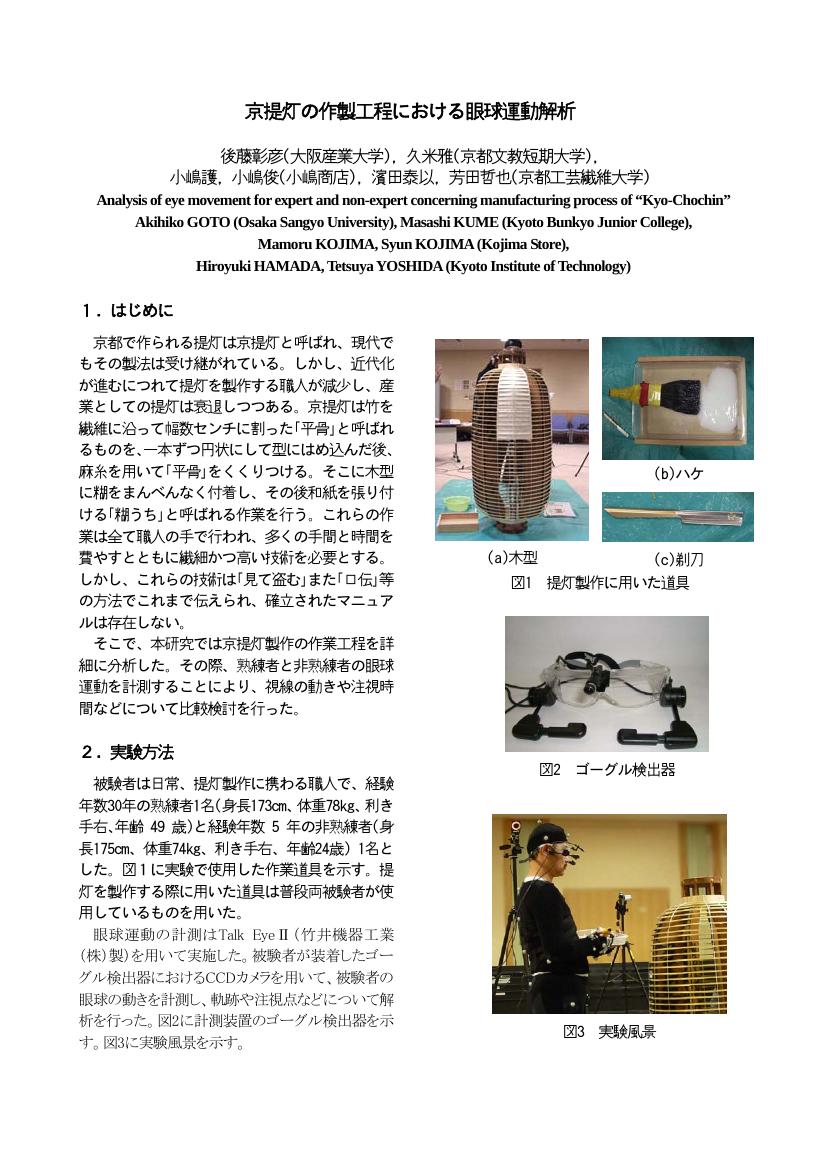26 0 0 0 OA Retraction:ソリッドカラーを用いた自動車修理塗装作業における熟練技術者の動作の特徴
- 著者
- 池元 茂 濱田 泰以 高井 由佳
- 出版者
- 一般社団法人 日本人間工学会
- 雑誌
- 人間工学 (ISSN:05494974)
- 巻号頁・発行日
- vol.52, no.5, pp.197-203, 2016-10-20 (Released:2017-11-28)
- 参考文献数
- 20
This article was retracted. See the Notification.
2 0 0 0 OA 京弓における材料技術
- 著者
- 濱田 泰以
- 出版者
- 公益社団法人 日本材料学会
- 雑誌
- 材料 (ISSN:05145163)
- 巻号頁・発行日
- vol.66, no.11, pp.811-815, 2017-11-15 (Released:2017-11-20)
- 参考文献数
- 2
- 被引用文献数
- 1
Production technology in traditional industries is inherited in the form of " remember while watching the back of the master." It is a knowledge base of the form of "tacit knowledge", and they need to be formalized by the power of science and technology. Movement of experts is recorded using an infrared camera. The position in the space of the marker affixed to each part of the body of the subject is acquired as digital data. In this report, Kyoto bow showed examples that formalized the tacit knowledge of manufacturing in traditional industries. Kyoto bow is a Japanese bow often used for archery enthusiasts. Mr. Shibata is the 21st bow priest. In order to elucidate the tacit knowledge, he possessed, vibration tests and bending tests were conducted. Test results proved that materials with high modulus of elasticity were chosen when Mr. Shibata chooses materials.
- 著者
- 西谷 啓吾 今井 裕里 野島 伸司 小牧 靖昌 濱田 泰以
- 出版者
- 一般社団法人 日本機械学会
- 雑誌
- 機械材料・材料加工技術講演会講演論文集
- 巻号頁・発行日
- vol.2018, 2018
1 0 0 0 OA 包丁の切れ味と熟練度の違いがダイコンのかつら剥きに与える影響
- 著者
- 飯 聡 濱田 明美 仲井 朝美 若山 雅文 芳田 哲也 濱田 泰以
- 出版者
- 一般社団法人 日本人間工学会
- 雑誌
- 日本人間工学会大会講演集 日本人間工学会第51回大会
- 巻号頁・発行日
- pp.246-247, 2010 (Released:2011-07-30)
1 0 0 0 OA 複合材料としての京壁
- 著者
- 小田原 晶子 佐藤 ひろゆき 杉江 朋彦 森迫 清貴 塩野 剛司 北島 佐紀人 仲井 朝美 濱田 泰以
- 出版者
- The Japan Society for Composite Materials
- 雑誌
- 日本複合材料学会誌 (ISSN:03852563)
- 巻号頁・発行日
- vol.35, no.1, pp.27-32, 2009 (Released:2010-11-30)
- 参考文献数
- 4
- 被引用文献数
- 3 2
There are many traditional technologies that have much knowledge to fabricate products in Japan. Such a knowledge is so-called technical intuitions and sensitivities. The craftsmen apply the technique for regenerating some traditional products and we defined the knowledge as “implicit knowledge.” The concept of this study is to scientifically analyze the implicit knowledge of those technologies. Here, the implicit knowledge would be traced from the contemporary view point. Thus, the knowledge can be applied to the modern technology which is adaptable to the market requirements. Finally the traditional technology retailed with the advanced technology many create a new technology. Kyokabe is one of Japanese clay wall for the traditional architectures. The clay wall consists of clay, sand and straws. Straws obviously play a reinforcement, thus Kyokabe can be treated as a composite material. Straws are immersed in the mixture of clay, sand and water for some period of time. The implicit knowledge which Plasterers (masters of Kyokabe) have acquired is that increase in the straws quantity results in increase in compressive strength and increase in the time improves workability in drawing. In this study, the implicit knowledge is scientifically resolved. The effects of the quantity and the immersion time on the compressive properties and workability of Kyokabe were also investigated.
1 0 0 0 OA 初期荷重下における組紐の引張力学特性評価手法
- 著者
- 花田 美和子 西脇 剛史 仲井 朝美 濱田 泰以
- 出版者
- 社団法人 繊維学会
- 雑誌
- 繊維学会誌 (ISSN:00379875)
- 巻号頁・発行日
- vol.60, no.2, pp.44-49, 2004 (Released:2006-02-09)
- 被引用文献数
- 1
Braids have been applied to various components for over one thousand years. Binding, bundling and hanging are listed in the representative uses of braids. The braids have characteristic mechanical properties, low modulus, large deformability, variable Poisson's ratio and low stiffness under flexural and compressive loads, and so on. Evaluation method of the braid properties has not been established. In order to clarify mechanical properties of the braids under the initial tensile loading quantitatively, an evaluation method is proposed in this study. By the application of the proposed method to three kinds of glass fiber braids, effects of braiding structure on the mechanical properties are discussed. Therefore the valid tensile testing method for evaluation of the braid properties could be proposed.
1 0 0 0 OA 京提灯の作製工程における眼球運動解析
- 著者
- 後藤 彰彦 久米 雅 小嶋 護 小嶋 俊 濱田 泰以 芳田 哲也
- 出版者
- 一般社団法人 日本人間工学会
- 雑誌
- 日本人間工学会大会講演集 日本人間工学会第51回大会
- 巻号頁・発行日
- pp.316-317, 2010 (Released:2011-07-30)
- 著者
- 遠藤 淳司 成田 智恵子 黒田 孝二 高井 由佳 後藤 彰彦 下出 祐太郎 濱田 泰以
- 出版者
- Japan Ergonomics Society
- 雑誌
- 人間工学 (ISSN:05494974)
- 巻号頁・発行日
- vol.50, pp.S328-S329, 2014

